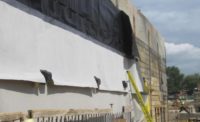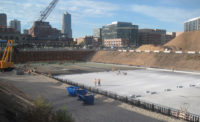Case Study: Below-Grade Waterproofing
Composite Waterproofing System Embraces Redundancy for Enhanced Performance

The SPS Infrastructure waterproofing team members work on the corner installation of the waterproofing membrane at Husky Stadium.

The external view of the Husky Stadium project site. The floor of the station was approximately 90 feet below grade.

The external view of the Husky Stadium project site. The floor of the station was approximately 90 feet below grade.



University Link Light Rail (U-Link) is an extension to the north of the Sound Transit Link light rail system in Seattle. When completed, the 3.15-mile light rail extension will run in twin-bored tunnels, bringing the region’s light rail system total to more than 19 miles. The tunnel requires a permanent waterproofing system to protect structures, electrical equipment, people, etc. The U-250 is about 100 feet underground with three station entrances and connections to the University of Washington campus by pedestrian bridge. Cooley Group manufactured the membranes and worked with BDA Associates and SPS Infrastructure Inc. to waterproof the Husky Stadium station segment of this project.
Project Scope
With underground stations at Capitol Hill and at the University of Washington’s Husky Stadium, the U-Link will serve the three largest urban centers in the state of Washington — downtown Seattle, Capitol Hill and the University District. The high-speed, high-capacity, congestion-free light rail originates at the Westlake station in downtown Seattle, continuing under First and Capitol Hill then under the Montlake Cut, and ending at the stadium beneath what is now surface parking lot E11. The footprint of the station is 780 feet long and 58 feet wide with a 32-foot wide station platform located 90 feet below grade. The addition of this one station is expected to add 71,000 riders to the system by 2030, bringing the system-wide total to 114,000.
Construction began on the two stations and tunnel track in 2009 and will continue until the rail officially opens for service in 2016. The estimated total subcontract cost for the concrete work is approximately $25 million, which includes redi-mix, concrete pumping, formwork, concrete finishing and concrete reinforcement.
SPS was tasked with waterproofing the station at Husky Stadium. The waterproofing team members assigned to this project had worked together on previous waterproofing projects throughout the country. One such project was the runway tunnels at Minneapolis International Airport, which they started in 1998 and completed in 2004 — it entailed approximately 6 million square feet of thermoplastic membrane with bentonite composite.
The group had developed a waterproofing system that used Cooley’s engineered membranes. Compared to other products in the market that are highly plasticized and break down over time, the Cooley membranes have a high resistance to chemicals while maintaining their flexibility, which was a big positive for this project.
Breaking Ground
Work on the Husky Stadium station began in spring of 2011. With most
projects of this nature, excavation begins from the bottom up, toward the surface. However, because of the planned depth for the floor of the station (about 90 feet below grade) and given the limited amount of space allotted to build the structure, the team faced a unique and unusual challenge.
The solution was to invert the process. They started construction from the top and worked their way down. Four-foot-wide exterior foundation walls were trenched out full depth, the rebar was placed down to the platform level and then the walls were filled with concrete. Once the concrete walls were set, they poured the roof and were then able to start excavation underneath the roof. They excavated down to the next level, poured the concrete and continued this process for a total of four levels until finally completing the platform, or basement level, last.
Choosing Materials
As the team had used successfully in previous projects, they opted for Coolguard® and Coolpro® membranes. Coolguard was used primarily because it is a heat-weldable waterproofing system, known for its flexibility and its high puncture and tear strengths. The membrane welds easily and is dimensionally stable. This is important because it allows for easy installation in changing climates and conditions. Because these systems protect people and equipment and have very long life expectancies, it is important that the waterproofing membrane not only protects from water, but that it has hydrocarbon and chemical resistance as well.
“This is an area that’s been overlooked in the past on typical waterproofing projects, but today it is of utmost importance, as ground water can be or can become contaminated,” said Ray Peebles, membrane specialist at Cooley Group. “Automobiles, large trucks and other equipment can leak fluids that can have damaging effects on many typical waterproofing systems.”
What makes the Coolguard membrane so resistant yet flexible and easy to weld is the use of Dupont™ Elvaloy® (KEE), a terpolymer component of a proprietary alloy material. Cooley has been working with Elvaloy technology for about 25 years. Combining this alloy with Cooley’s own proprietary chemistry makes Coolguard intrinsically resistant to hydrocarbons and other chemicals in challenging environmental applications where standard flexible PVC — which is commonly used in this type of project — may not stand up. It also makes it more durable and very flexible, even though it is not a plasticizer.
Waterproofing
With the workspace created and the materials selected, the team began to work on the actual waterproofing. They used a composite waterproofing system — an approach where two or more independent waterproofing layers are combined or overlaid onto each other to form one multi-component matrix.
“Most waterproofing manufacturers of individual systems would profess that there is no need for supplemental layer(s) if their system was properly installed as one layer,” said Brent Anderson, consulting engineer at BDA Associates. “However, most experienced contactors want a high level of redundancy in their waterproofing system — that’s the reason for the composite. It generally takes many years of field performance and material compatibility assurance before manufacturers may want to warrant compatibility or performance of another product that is part of their system. This is understandable because experience and testing by the manufacturer requires time to gain assurance by those who provide such warranties.”
Of the two systems installed, the first was a waterproofing system to the exterior of the structure, and the second was a water seepage management system for the interior space. The exterior system consisted of the Coolguard membrane and a bentonite clay layer of 1.5 pounds per square foot (placed between the membrane and concrete substrate), which together formed a dual-layer waterproofing system, and was followed by a protective layer to shield the system.
“We were able to start applying the Coolguard membrane system immediately after the roof was poured,” said Steve McDonald, project manager for SPS, who oversaw the project. “This was critical in allowing us to keep to a fast-paced schedule.”
It is important that both the membrane and concrete substrate are in direct contact with bentonite clay. Bentonite sheet systems that are contained in cardboard panels — or have polyethylene on one side only, or further, are covered with geotextile fabric on one or both sides — are not as effective in eliminating water migration between the membrane and the concrete substrate. When bentonite is properly sandwiched between the underside of the membrane and the top of the concrete surface, water migration is eliminated.
The second system, or the interior seepage management system, consisted of a layer of dimple-sheeting drainage mat and then a layer of Coolpro material. The system was installed at the inside face of the slurry walls behind the architectural finishes. When using impermeable membranes, they are effective at stopping water from seeping in, but then the water has nowhere to go. This system — along with the drain pipes and the membrane — is designed to collect the water, which it then directs to sumps, away from the tunnel. The flexibility of the Coolpro membrane allows the installation of the system to be placed over the less-than-perfect, blindside-poured slurry walls.
“Highly experienced designers and contractors many times find themselves developing waterproofing systems and/or multi-component layering techniques, providing enhanced performance in challenging jobsite conditions,” Anderson said. “This development of multi-layering, whereby one or more systems may be combined to form a “composite,” is becoming more common in the industry.”
Outlook
The waterproofing portion of the Husky Stadium station is expected to be complete in late 2013, as scheduled. “Compared to other waterproofing systems, this one is very user-friendly, and with the Cooley membrane, it’s easy to achieve a high-quality weld,” McDonald said. “The ease of installation of this system allowed us to stay on track with the project schedule; there were no mishaps that set us back.”
Looking to the future, the team sees the hydrocarbon/chemical resistance of the membranes as one of their most prominent features. “More and more engineers are going to understand that many projects not only need to be waterproofed, but that the membranes used also need to be resistant to chemicals, benefitting their project both from a safety and performance perspective,” Peebles said. “Right now, chemical resistance is not always required— but it should be.”
The system used in this project is ideal for any waterproofing application that needs extra security or has elevated concern with other contaminants that may be in the water in that specific area. “Going forward, we’ll see this required on more projects, and people will like the system and how it installs,” Anderson said. “Owners will be very satisfied and happy with its performance.”
Looking for a reprint of this article?
From high-res PDFs to custom plaques, order your copy today!







